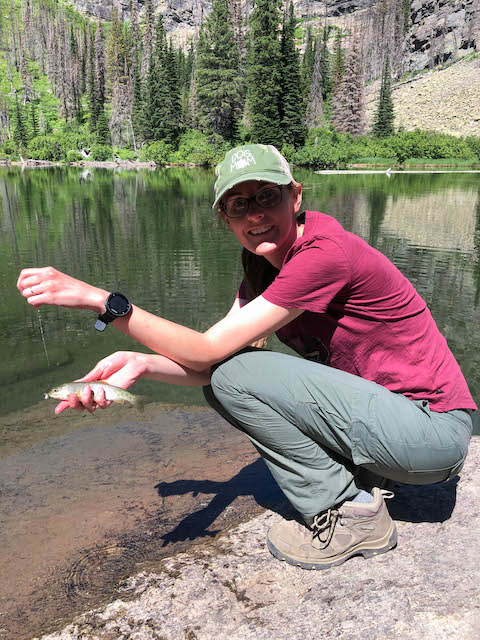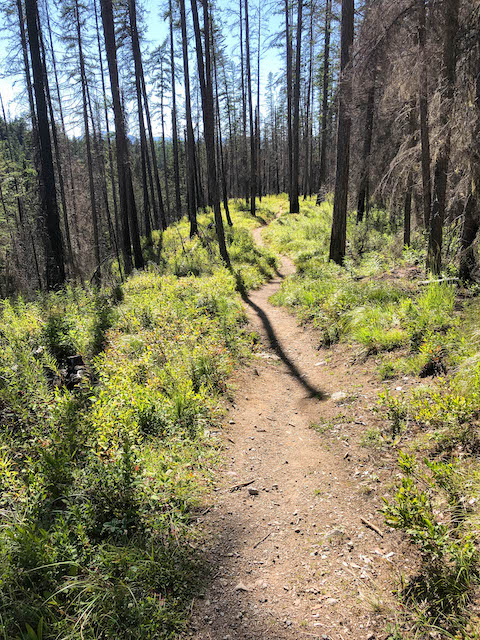One advantage of the early starts we were getting every day was the chance to enjoy sunrise every morning. This is something I always enjoy as a fishing guide since I’m often on the road by five or six each morning. For this day of hiking, we hit the road by about 5:30 am and were none too early. We got one of the last parking spots when we arrived at the Logan Pass Visitor Center around 6:30 am.
Our plan was to wander down to Hidden Lake and maybe even enjoy some fishing. This lake is supposed to contain Yellowstone cutthroat trout that are relatively easy to catch. The Tenkara rod was packed accordingly along with snacks, bear spray, water, and of course our cameras. We had our quick breakfast of fruit, granola, yogurt, and nuts and noticed quite a few other people doing the same thing. Soon we were done and ready to start moving.
Hiking to Hidden Lake in Glacier National Park
As we walked across the parking lot and up the stairs to find the beginning of the trail behind the visitor center, we were excited for what the day might hold. This excitement was quickly tempered when we found a sign at the beginning of the trail announcing a closure from the overlook onward. Apparently, the trail was closed because the cutthroat were spawning, and the bears were concentrated in area of the outlet stream looking fish to eat. Another bummer, but also another reason we need to return to Glacier National Park for another try. Still, we were already there and ready to walk. Up to the overlook we went.This was the most crowded trail we hiked in Glacier with only the Avalanche Lake Trail being anywhere close. The reason for these trails’ popularity becomes obvious when you realize that they are two of the shortest trails and also two of the more scenic. Soon, we would be looking for longer hikes that would offer more solitude. At this moment, though, we were just happy to be tourists and see the sights.
The trail is a boardwalk for quite a distance. This helps protect the fragile alpine environment (please stay on the trail!!!) and also inadvertently provided some type of structure for marmots to live under. We found one of my favorite creatures of the Rockies early in our hike, and I had to stop for some pictures before moving on.
The trail heads slowly uphill towards the southeast flank of Clements Mountain. Wildflowers were abundant here. While I was tempted to pull out my good camera, I kept using my cellphone and snapped a few quick shots of the glacier lilies which reminded me a lot of the trout lilies back home in Tennessee. In hindsight, I wish I had spent more time photographing them as we wouldn't find many more during our time in Glacier National Park. I didn't realize it at the time, but we were already late in the season to be finding them. Most of the specimens we saw were already starting to fade and wilt.
Up high, large snow fields were still blocking the trail. We joined the throng of hikers slipping and sliding our way across the snow. As you hike, you are surrounded by big views everywhere you look. We could easily have spent our entire day wandering along this short section of trail with our cameras, but we had other plans.
Mountain Goats Near Hidden Lake Overlook
Approaching the overlook, we noticed some mountain goats off to the north side of the boardwalk. They were really close to the trail. It was time to get out the “good” cameras instead of our cellphones we were using for quick pictures. One thing that both myself and my lovely wife enjoy is wildlife photography. Seeing animals that we don’t have in Tennessee is a highlight of our trips out west. We both turned our backs to the incredible scene of Hidden Lake and started photographing the mountain goats. The pictures were not anything fancy, but we were nice and close which made for good crisp pictures.
Soon enough, the mountain goats wandered off and we turned back to the scene before us. Hidden Lake is spectacularly beautiful. I hate that we didn’t get to hike on down to the lake, but we enjoyed the views we had and the extra time it saved allowed us to enjoy some other portions of the park.
Finishing the Hidden Lake Overlook Hike
With our cameras already out, we sauntered back towards the trailhead rather slowly. Taking lots of pictures along the way, we eventually were back near the beginning.
I finally slowed down long enough to enjoy some of the wildflowers before continuing on to the car. The spring beauties (second picture) were the first that I actually recognized although all the wildflowers were beautiful. The coiled lousewort (first picture) was one I had to look up later. I found out it is closely related to one of my favorites, elephant head lousewort. Seriously, they look like tiny pink elephant heads!
Back in the parking lot, we made someone very happy when they discovered we were about to leave. Vehicles of all shapes and sizes were circling continuously in search of a place to park. Access is definitely an issue at this park, and with the shuttle system shut down because of COVID along with the entire eastern side of the park, this problem was exacerbated. As we exited the parking lot, I turned the car east.
We decided to drive as far as possible and look for bears and other wildlife. This would become another daily ritual. Whenever we finished a hike with time to spare, we would drive along the Going to the Sun Road in search of wildlife. The road was open all the way to a roadblock along Saint Mary Lake. With the east side of Glacier National Park completely shut down due to COVID, people had to turn around at this point.
We stopped at the Wild Goose Island Lookout and took a few pictures before continuing onward. We were lucky to find the lake calm as glass and reflecting the mountainous background like a mirror. This side of Glacier tends to be windy, so this was quite the treat.
On this day, the wildlife managed to elude us except for some glorious views. As we headed back west, a stop at camp sounded like a plan along with a trip to town. We wanted to pick up a few groceries in town and check out a different section of Glacier National Park.
Fly Fishing the North Fork Flathead River near Polebridge, Montana
After the town stop, we headed north to Pole Bridge. This area of the park does not see as much visitation as the famous Going to the Sun Road, but there were still plenty of people around. One bonus of this portion of Glacier National Park lies in the fishing regulations. The North Fork of the Flathead River can be fished without a fishing license, provided that you are accessing it from Glacier National Park and not from Montana state lands. My good friend Bryan Allison had given me a tip on fishing that area, so I was anxious to give it a try. Thankfully, some reasonable access was not too hard to figure out.
The warm afternoon breeze had me thinking hoppers. I quickly rigged a fly rod with a big foam bug and was soon wading in my sandals. Surprisingly, the fish would at least check out my offering but were being a little shy. I’m guessing they got at least some pressure based on both the fishermen’s trail from where we parked and also the constant parade of boats going by. At least a few of the passing boats contained anglers.
Finally, after switching flies a few times, I settled on a small yellow stimulator and was soon catching plenty of fish. They weren’t really picky exactly, but they did want something a little more natural. Despite my hopes, there wasn’t a massive grasshopper hatch in progress and the fish were looking for aquatic insects hatching. The bright sunny day had some caddis popping along with a few smaller stoneflies. Interestingly, they weren't as interested in nymphs or pupa patterns as they were in dry flies. Cutthroat trout just really like dry flies!
The fish here are not big, or at least I didn’t find any large ones. They were larger than the small fish at Snyder Lake the day before though. They were also reasonably willing to eat a fly, at least once the correct fly was tied on. I caught a few and offered the rod to my wife, but she declined. I got the idea that she might prefer to continue our search for animals, so before long we were back on the road. It was getting later in the day now, and we hoped to find some wildlife moving about.

























































